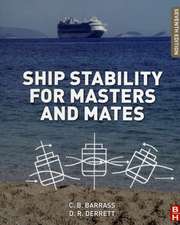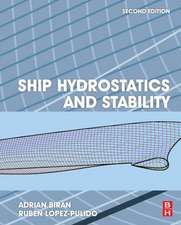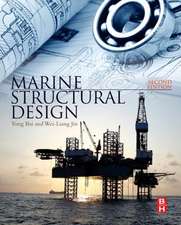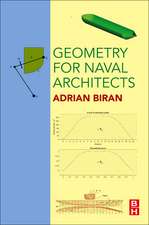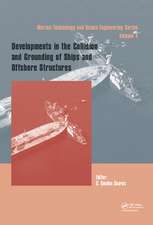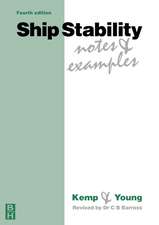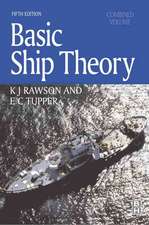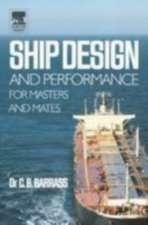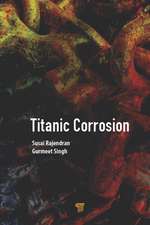Practical Ship Design
Autor D.G.M. Watsonen Limba Engleză Paperback – 22 feb 2002
It deals with every aspect of ship design and handles a wide range of both merchant ships and naval ships with authority. It provides coverage of cargo ships and passenger ships, tugs, dredgers and other service craft. It also includes concept design, detail design, structural design, hydrodynamics design, the effect of regulations, the preparation of specifications and matters of costs and economics.
Drawing on the author's extensive practical experience, Practical Ship Design is likely to interest everybody involved in the design, construction, repair and operation of ships. Students and the most experienced professionals will all benefit from the book's vast store of design data and its conclusions and recommendations.
| Toate formatele și edițiile | Preț | Express |
|---|---|---|
| Paperback (1) | 537.19 lei 5-7 săpt. | |
| ELSEVIER SCIENCE – 22 feb 2002 | 537.19 lei 5-7 săpt. | |
| Hardback (1) | 656.66 lei 5-7 săpt. | |
| ELSEVIER SCIENCE – 14 dec 1998 | 656.66 lei 5-7 săpt. |
Preț: 537.19 lei
Preț vechi: 695.28 lei
-23% Nou
Puncte Express: 806
Preț estimativ în valută:
102.80€ • 111.63$ • 86.35£
102.80€ • 111.63$ • 86.35£
Carte tipărită la comandă
Livrare economică 15-29 aprilie
Preluare comenzi: 021 569.72.76
Specificații
ISBN-13: 9780080440545
ISBN-10: 0080440541
Pagini: 558
Ilustrații: black & white illustrations
Dimensiuni: 159 x 241 x 25 mm
Greutate: 0.98 kg
Ediția:Revised
Editura: ELSEVIER SCIENCE
ISBN-10: 0080440541
Pagini: 558
Ilustrații: black & white illustrations
Dimensiuni: 159 x 241 x 25 mm
Greutate: 0.98 kg
Ediția:Revised
Editura: ELSEVIER SCIENCE
Cuprins
Chapter headings and selected papers: Foreword. Preface. Introduction, Methods and Data. Design calculation methods. Ship design data. Setting Design Requirements. Merchant ship requirements and transportation studies. Staff requirements for warship and naval auxiliary vessels. The Design Equations. The weight equations. The volume equations. Weight-Based Designs. Outfit weight calculations. Lightship centres of gravity. Volume, Area and Dimension-Based Designs. Estimating the required volume. Crew numbers. Powering I. An introduction to powering. Resistance and ship model correlation. Powering II. Propulsive efficiency. Design Of Lines. The bow and stern. Seakeeping and manoeuvrability. Machinery Selection. Introduction and criteria for choosing the main engine. Structural Design. Factors influencing structural design. Special strength considerations for particular ship types. Freeboard and Subdivision. Deterministic rules for passenger ships. Probabilistic rules for cargo ships. Stability and Trim — General. Damaged stability standards for reduced freeboard. Constant displacement and added weight. Other Statutory Rules. MARPOL — marine pollution rules. Tonnage rules. Special Factors Influencing Warship Design. Warship roles. Combat systems. The General Arrangement. Factors influencing the general arrangement. Arranging accommodation. General Arrangement of Some Ship Types. A specialist ship — R.D.N. fishery inspection ship "Thetis". Guidance on designs from significant ships. Specification and Tender Package. Specification principles. Things to avoid when writing, or accepting a specification. Cost Estimating. Cost and price. Structural costs. Operational Economics. Economic criteria. Operating costs. Conversions. Modifications to increase deadweight or capacity. Bibliography. Subject index.
Recenzii
"With a detailed look at the preliminary approaches used in ship design, this is one of the most useful books on naval architecture and marine engineering to be published for a long time.(...)Written is a simple style with clear explanations of concepts and sources the book contains a wealth of practical information with graphs taken from actual service vessels.(...)the book is essential reading for all naval architecture undergraduates and a must for University libraries offering marine engineering courses." --Marine Engineers Review

